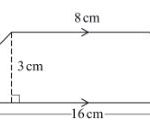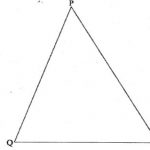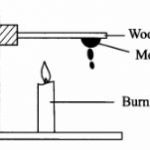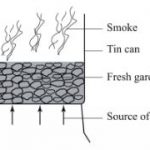KENYA NATIONAL EXAMINATION COUNCIL K.C.P.E 2012 Science
The Kenya National Examination Council
14/11/2012
DAY 2
Wednesday
Time: l hour 40 minutes
8.00 am — 9.40 am
Instructions to candidates (Please read these instructions carefully)
1.You have been given this question booklet and a separate answer sheet. The question booklet contains 50 questions.
2. Do any necessary rough work in this booklet.
3. When you have chosen your answer, mark it on the ANSWER SHEET, not in this question booklet.
How to use the answer sheet
4. Use an ordinary pencil only.
5. Make sure that you have written on the answer sheet:
Your index number
Your name
Name of your school
6. By drawing a dark line inside the correct numbered boxes, mark your full index Number (i.e. School Code Number and the three-figure Candidate’s Number) in the grid near the top of the answer sheet. 7. Do not make any marks outside the boxes.
8. Keep the sheet as clean as possible and do not fold it.
9. For each of the questions 1 — 50, four answers are given. The answers are lettered A, B, C and D. In each case only ONE of the four answers is correct. Choose the correct answer.
10. On the answer sheet, show the correct answer by drawing a dark line inside the box in which the letter you have chosen is written.
Example
In the Question Booklet.
4. Which one of the following is a storage pest?
A. White Ant.
B. Weaver bird.
C. Cutworm.
D. Aphid.
The correct answer is A.
On the answer sheet:
4. [A] [B] [C] [D] 14.[A] [B] [C] [D] 24.[A] [B] [C] [D] 34.[A] [B] [C] [D] 44.[A] [B] [C] [D]
in the set of boxes numbered 4, the box with the letter A printed in it is marked.
11. Your dark line MUST be within the box.
12. For each question ONLY ONE box is to be marked in each set of four boxes.
This Question Paper consists of 7 printed pages.
The Kenya National Examinations Council, 2012
1. Which of the following is a tuber crop‘?
A. Onion.
B. Carrot.
C. Pineapple.
D. Cabbage.
2. A beam balance is used for
A. measuring volume of objects
B. comparing mass of different objects
C. measuring height of objects
D. comparing size of different objects.
3. In which of the following groups of activities is friction NOT required?
A. Writing and erasing.
B. Skating and braking.
C. Flying and swimming.
D. Walking and riding.
4. Animals provide plants with
A. support and carbon dioxide
B. manure and oxygen
C. carbon dioxide and pollination
D. pollination and oxygen.
5. Which of the following statements about blood vessels in the human body is CORRECT?
A. All veins carry de-oxygenated blood.
B. Blood pressure in arteries is higher than in veins.
C. Arteries have valves that control flow of blood.
D. Arteries have thinner walls than those of veins.
6. Which of the following CORRECTLY represents the path taken by food from the esophagus‘?
A. Stomach ——> small intestines —-> large
intestines —> rectum —> anus.
B. Small intestines ——> large intestines ——> stomach —> rectum ——> anus.
C. Stomach —> large intestines —> small intestines —> rectum ——> anus.
D. Large intestines —> stomach —> small intestines ——> rectum ——> anus
7. Which of the following types of human teeth is CORRECTLY matched to its function?
Teeth Function
A. incisors Tearing and cutting.
B. Canines Tearing and crushing.
C. Premolars Cutting and grinding.
D. Molars Crushing and grinding.
8. A plant which has deep and widely spread root system is LIKELY to have
A. broad leaves
B. many leaves
C. succulent stems
D. weak stems.
9. Which of the following groups of crops consists of cereals ONLY?
A. Peas, beans and green grams.
B. Maize. rice and sorghum.
C. Millet, cow peas and maize.
D. Green grams, sorghum and rice.
10. The diagrams below represent two levers E and F with different positions of load, effort and fulcrum.

The levers represented by E and F are
E F
A. spade crawbar
B. wheelbarrow claw hammer
C. claw hammer crawbar
D. spade wheelbarrow
11. Which of the following pairs of plants is CORRECTLY matched with the type of root system
Tap root Fibrous root
A. grass wheat
B. tomato black jack
C. coconut acacia
D. kale onion
12. The following are statements about how different simple machines make work easier.
(i) Making the slope gentle.
(ii) Reducing the effort applied.
(iii) Changing direction of the force applied.
(iv) Reducing friction.
Which of the statements apply to a single fixed pulley?
A. (i) and (iv).
B. (i) and (ii).
C. (ii) and (iii).
D. (iii) and (iv).
13. Which of the following groups of animals consists ONLY of invertebrates?
A. Crab. newt and snail.
B. Centipede, snail and spider.
C. Newt, centipede and slug.
D. Slug. frog and crab.
14. Which of the following statements is TRUE?
A. Fish have constant body temperature.
B. Birds have varying body temperature.
C. Young ones of amphibians live on land.
D. Reptiles breathe through the lungs.
15. Which of the following are examples of herbivores. carnivores and omnivores?
Herbivore Carnivore Omnivore
A. Hippopotamus Crocodile Chimpanzee.
B. Zebra Lion Vulture.
C. Gorilla Leopard Hyena.
D. Buffalo Baboon Rhino.
16. Which of the following pairs consists only of animals with scales?
A. Toad and duck.
B. Turtle and salamander.
C. Turtle and duck.
D. Salamander and toad.
17. The following are some practices that help prevent the spread of water borne diseases.
(i) Using toilets for urination.
(ii) Washing fruits before eating them.
(iii) Washing hands before eating.
(iv) Wearing gumboots when walking in stagnant water.
Which practices will help control the spread of bilharzia?
A. (i) and (ii)
B. (i) and (iv)
C. (ii) and (iii)
D. (iii) and (iv)
18. Transfer of heat by convection takes place in A. gases and liquids
B. solids and liquids
C. solids and vacuum
D. gases and vacuum.
19. The diagram below represents the processes I, II. III and [V that are involved in change of states of matter.

Which of the following CORRECTLY represents the processes?
I Il III IV A. Melting Freezing Evaporation Condensation
B. Condensation Evaporation Melting Freezing.
C. Evaporation Melting Freezing Condensation.
D. Melting Freezing Condensation Evaporation.
20. The pie chart below shows proportions of G, H. J and K that represent the components of air.
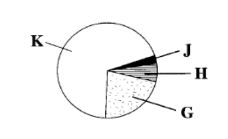
Which proportion CORRECTLY represents a gas used in fire extinguishers and a gas used in an electric tube?
used in fire extinguisher used in electric tube
A. K H
B. G K
C. J H
D. G J
21. Which of the following factors makes wax to float on water?
A. Shape of material.
B. Type of material.
C. Size of material.
D. Muss of material.
22. In which of the following are both materials CORRECTLY grouped as magnetic and non» magnetic?
Magnetic Non-magnet
A. Copper Zinc.
B. Zinc Steel.
C. Aluminium Copper.
D. Steel Aluminium.
23. The following are activities carried out to investigate the effect of heat on a liquid.
(i) Placing the bottle on a source of heat.
(ii) Filling the bottle with coloured water.
(iii) Fixing a straw on the cork.
(iv) Closing the battle tightly with the cork.
Which one of the following is the CORRECT ORDER of the activities?
A. (ii), (iii), (iv), (i).
B. (iii), (iv),(ii), (i).
C. (ii).(i),(iii),(iv).
D. (iii). (ii), (i), (iv)
24. The diagram below shows a set-up that can be used to investigate the effect of heat on matter.
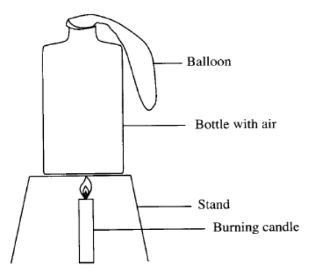
The effect investigated is
A. gases change state when heated
B. solids expand when heated
C. gases expand when heated
D. solids change state when heated.
25. The diagram below represents a set-up in which a ruler is fixed to a desk and its free end pulled to positions L. M. and N. At each position the free end is released to produce sound.
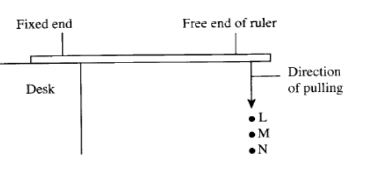
The set-up can be used to investigate
A. special sounds
B. loud and soft sound
C. direction of sound
D. noise pollution.
26. A card made in the shape of letter E and numbers 1, 2 and 3 written on it was placed in front of a mirror as shown in the diagram

which one of the following is correctly represented?
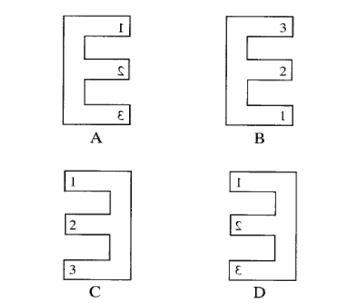
27. The reason why improved jikos have a clay D Splagh erogkm lining is to
A. reduce the amount of heat loss
B. reduce the space for charcoal
C. make charcoal light faster
D. make the jiko last longer.
28. Which of the following practices will NOT result in a person getting an electric shock? A. Touching sockets with wet hands.
B. Putting pencils in sockets.
C. Overloading the sockets.
D. Putting iron nails in sockets.
29. Which of the following groups of sources of energy arc renewable?
A. charcoal. kerosene. sawdust.
B. water. firewood. animal dung.
C. Diesel. wind, natural gas.
D. Biogas. petrol, coal.
30. Which of the following pairs of food is preserved by smoking, salting and drying‘?
A. Meat and mushrooms.
B. Beans and fish.
C. Mushrooms and beans.
D. Meat and fish.
31. Which of the following is the MAIN which of the following CORRECTLY reason why eating bread after expiry date is represents the image as seen in the minor‘? discouraged? The bread could have
A. lost nutrients
B. a bad taste
C. some micro-organisms
D. changed its colour.
32. Which of the following pairs consists of diseases caused by lack of minerals in the diet‘?
A. Anaemia and rickets.
B. Kwashiokor and anaemia.
C. Marasmus and Kwashiokor.
D. Rickets and marasmus.
33. A hilly area with deep channels is LIKELY to be experiencing
A. sheet erosion
B. gulley erosion
C. rill erosion
34. The diagram below shows an improvised rain gauge.

The collecting bottle should
A. have the funnel sealed to its mouth
B. be wide to collect enough water
C. be placed above the ground
D. be transparent for easy reading.
35. The diagram below represents a model of the solar system prepared by class six pupils.
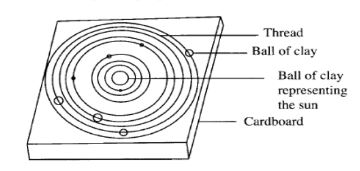
The mistake made in the model was
A. using threads instead of wires
B. placing a ball of clay next to the one representing the sun
C. placing two balls of clay on one thread
D. using balls of clay of different sizes.
36. The MAIN reason why mothers are encouraged to breast feed their infants is because breast milk
A. boosts immunity of the infant
B. is free from disease causing germs
C. is at the right temperature for infants
D. is easily digested by infants.
37. A person in the incubation period of HIV infection will show
A. signs and symptoms but test negative
B. no signs and no symptoms but test positive
C. no signs, no symptoms and test negative
D. signs, symptoms and test positive.
38. Which of the following is a preventive measure against the spread of tuberculosis?
A. Clearing bushes around houses.
B. Boiling drinking water.
C. Proper disposal of human waste.
D. Living in a well ventilated house.
39. In which of the following are characteristics of cumulus and nimbus clouds CORRECTLY placed‘?
Cumulus Nimbus
A. Dark grey in colour Appear like bundles of cotton.
B. Mountainous in shape white in colour.
C. White in colour Mountainous in shape.
D. Rain bearing Dark grey in colour.
For two masses X and Y. the mass of X was twice that ofY. The diagram below shows a set-up that was used to investigate how the two masses balance at positions Q. R. S and T on a seesaw.

Which of the following was a correct observation about the investigation?
Position Position Observation made
of X of Y Q T End P moved down
R T End V moved up.
Q S Seesaw balanced.
R S End V moved down
41. The diagram below represents a simple electric circuit.

Which of the following energy transformations would take place when the switch is on‘?
A. Chemical—> electrical—>heat—> light.
B. Electrical—> chemical-alight——> heat.
C. Chemical—> electrical—> light—> heat.
D. Electrical—> light—>chemical—> heat.
Which of the following practices LEAST pollutes the soil?
A. Spraying crops to kill pests.
B. Burning plant wastes in the farm.
C. Disposing of animal wastes in the farm.
D. Burying plastics in the soil.
43. In an investigation. equal amounts of soap was added to equal amounts of water samples W and Z obtained from different sources.
The following observations were made:
(i) W formed lather.
(ii) Z formed suspended particles.
Which of the following statements about W and Z is NOT CORRECT?
A. W may have fewer minerals.
B. Z may form lather after boiling.
C. W can form scales in kettles.
D. Z wastes soap when washing.
44. Which of the following consists of materials with a definite volume and definite shape?
A. Water, bottle. stone.
B. Paper, pin, ink.
C. Kerosene. cooking oil. milk.
D. Sand. colour, sugar.
45. Which of the following practices will conserve soil?
A. Using dry grass for mulching.
B. Buring vegetation on farms.
C. Ploughing along the slope.
D. Burying plastic materials.
46. Soil becomes waterlogged due to A. its colour
B. the size of its particles
C. the absence of small animals in it
D. the amount of air in it.
47. Which of the following is the CORRECT procedure that is used to obtain clear water from muddy water?
A. Filtering and decanting.
B. Evaporating and filtering.
C. Decanting and filtering.
D. Evaporating and decanting.
48. Which of the following pairs of practices will control ticks, fleas and lice in livestock?
A. Spraying and de-worming.
B. Herding and dipping.
C. De-worming and rotational grazing.
D. Dipping and spraying.
49. Which one of the following statements is TRUE about manures? They
A. increase the growth of weeds
B. release specific nutrients to the soil
C. destroy micro-organism in the soil
D. cause pollution of the soil.
50. The following are activities that pollute the environment.
(i) Burning charcoal in a closed room.
(ii) Oil spillage from tankers.
(iii) Using diesel as fuel in vehicles.
(iv) Dumping vegetable waste.
Which activities pollute air? A. (i) and (iv).
B. (ii) and (iv).
C. (ii) and (iii).
D. (i) and (iii).
Free KNEC KCPE Past Papers Science 2012 Answers
K.C.P.E 2012 ANSWERS
# Science
1 B
2 B
3 C
4 C
5 B
6 A
7 D
8 C
9 B
10 A
11 D
12 D
13 B
14 D
15 A
16 C
17 B
18 A
19 A
20 C
21 B
22 D
23 A
24 C
25 B
26 D
27 A
28 C
29 B
30 D
31 C
32 A
33 B
34 D
35 C
36 A
37 B
38 D
39 C
40 A
41 A
42 C
43 C
44 D
45 A
46 B
47 C
48 D
49 A
50 D

